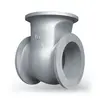Mobile:+86-311-808-126-83
Email:info@ydcastings.com
Italian
Understanding the Fundamentals and Techniques of Sand Casting in Metalworking
Understanding Sand Casting A Fundamental Manufacturing Process
Sand casting, also known as sand mold casting, is one of the oldest and most widely used metal fabrication processes in manufacturing today. This method involves creating a mold out of sand to form a desired shape, which is then filled with molten metal to produce a final product. Its versatility and relatively low cost have established it as a preferred technique in various industries, from automotive to aerospace.
The sand casting process begins with designing a pattern, typically made from wood, metal, or plastic, which replicates the desired product
. This pattern is then pressed or packed into a mixture of sand and binding agents to create a mold. The properties of the sand are crucial; it must have sufficient strength to withstand the weight of the molten metal yet remain porous enough to allow gases to escape.Once the mold is formed, it is carefully separated and the pattern removed, leaving a hollow cavity in the shape of the desired part. This process is generally followed by the assembly of two mold halves, which are then securely clamped together. The next step involves pouring molten metal into the mold through a sprue, allowing it to fill the cavity completely.
sand casting

After the metal has cooled and solidified, the mold is broken open to reveal the cast part. Sand casting can accommodate a wide range of metal alloy types, including iron, aluminum, and bronze, making it suitable for producing both small and large components with complex geometries.
One of the significant advantages of sand casting is its ability to produce large parts and components at a relatively low cost, especially for short production runs. Furthermore, it has the flexibility to create intricate designs that would be challenging to achieve with other manufacturing methods. However, it is essential to consider that sand casting may yield a rougher surface finish than other techniques, necessitating post-casting processes such as grinding or machining to meet specific tolerances.
In conclusion, sand casting remains a cornerstone of manufacturing due to its adaptability, cost-effectiveness, and ability to produce complex shapes. As technology advances, the integration of sophisticated design software and automation in sand casting processes continues to enhance its efficiency and precision, ensuring its relevance in the modern manufacturing landscape. Whether for custom parts or high-volume production, sand casting offers a reliable solution for various engineering challenges.











